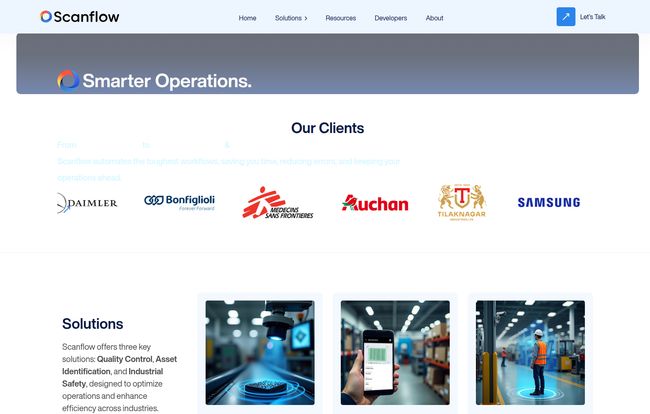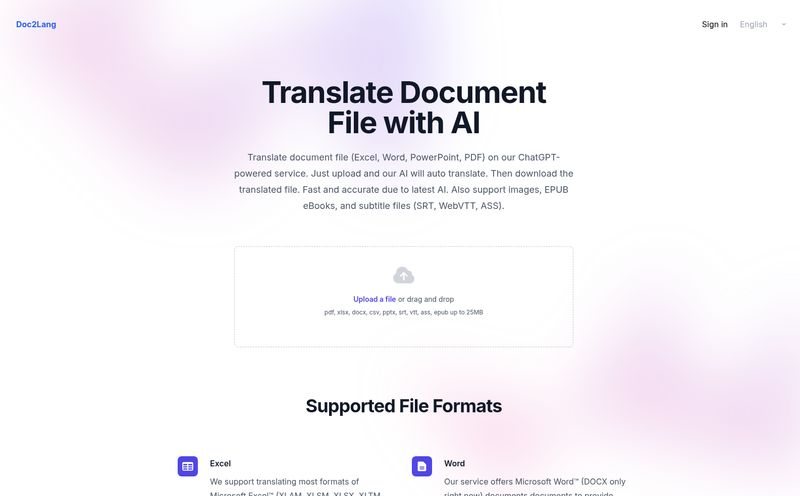I’ve spent more hours than I’d like to admit in my career watching operations grind to a halt because of a single, tiny bottleneck. You know the one. The manual quality check. The hunt for the right serial number on a dusty pallet. The painstaking process of logging assets with a clipboard and a pen. It’s a special kind of operational purgatory, and frankly, it’s where profits go to die.
So, whenever a platform like Scanflow appears on my radar, waving its hands and claiming to automate all that with a slick AI-powered app, I'm both skeptical and incredibly intrigued. Is this just another tech solution looking for a problem, or is it the real deal? I decided to take a closer look.
So, What Exactly Is Scanflow Anyway?
Let's cut through the marketing jargon. At its heart, Scanflow is a platform that turns a regular smart device—like the phone in your pocket or a ruggedized tablet—into a seriously intelligent data-capturing tool. Think of it as giving your standard smartphone camera a PhD in industrial engineering and a black belt in efficiency. It's not just about scanning a barcode; it’s about understanding what it’s looking at.
The company works with some absolute giants—we're talking Daimler, Samsung, and Auchan. When you see names like that, you know they're not just playing around. These companies don’t adopt new tech unless it provides a rock-solid return on investment. This tells me Scanflow is likely solving some very expensive, very real problems.

Visit Scanflow
The Core Features That Actually Matter
A features list is just a list until you see how it applies in the real world. Scanflow’s capabilities seem less like a random collection of tools and more like a cohesive system designed to tackle specific industrial headaches.
More Than Just a Barcode Scanner
Sure, it has a Barcode and QR Code Scanner SDK, which is table stakes these days. But where it gets interesting is with its Object Detection and Serial Code Scanning. This means an operator on the factory floor doesn’t need to hunt for a tiny barcode. They can just point their device at a component, and Scanflow can identify the part itself or read a stamped serial number, even if it’s worn or partially obscured. That’s a game-changer for speed and reducing frustration.
Your New Digital QA Inspector
This is the part that gets me really excited. The Quality Control feature promises real-time defect identification. Imagine a production line where, instead of relying solely on the tired eyes of a human inspector at the end of the day, a simple scan can instantly flag a cosmetic flaw, a missing component, or an assembly error. The potential to catch mistakes as they happen, rather than after you’ve produced 10,000 faulty units, is enormous.
Taming the Asset Management Beast
For anyone in logistics or large-scale manufacturing, Asset Identification is a constant battle. Tracking tools, parts, and finished goods is a full-time job. Scanflow aims to simplify this by making every item easily identifiable with a quick scan. This ties directly into their Industrial Safety solutions, ensuring the right equipment is in the right place and that safety checks are properly logged, creating a digital paper trail that’s a lot more reliable than a dusty binder in a back office.
How Scanflow Claims It Can Transform Your Ops
Scanflow isn’t shy about the results they deliver. Their site highlights some pretty bold numbers:
- 70% Test Automation
- 60% Faster Automation
- 40% Cost Reduction
Now, as an SEO and trends guy, I've seen my fair share of impressive stats. But let’s break down what this actually means on the ground level. A 70% increase in test automation means you're freeing up your skilled technicians from repetitive checks to focus on higher-value problems. 60% faster automation directly translates to higher throughput and quicker turnarounds. And a 40% cost reduction? That’s the kind of number that gets any CFO's attention, stemming from fewer errors, less waste, and optimized resource allocation.
The Deployment Triple-Threat: Edge, Cloud, and Offline
Here’s where the tech gets really clever and shows a deep understanding of its target users. Scanflow isn’t a one-trick pony when it comes to deployment. They offer three distinct models:
- Edge: All the AI processing happens directly on the device. This is brilliant for two reasons: it’s incredibly fast (no lag from sending data to a server), and it's secure, which is perfect for sensitive or proprietary information that shouldn’t leave the facility.
- Cloud: For operations that need global access and centralized data management, the cloud model makes perfect sense. It allows for broader oversight and easier updates across multiple locations.
- Offline: This, for me, is the real clincher. I’ve been in enough cavernous warehouses and remote sites to know that reliable Wi-Fi is often a myth. The ability for Scanflow to work offline and sync data later ensures that operations don't just stop because the internet decides to take a coffee break. It’s a practical solution for a messy, real-world problem.
Let's Talk Brass Tacks: Industries and Implementation
Scanflow is clearly targeting heavy hitters. Their primary industries include Manufacturing, Logistics & Supply Chain, Automotive, Pharmaceuticals, and Retail. This focus makes sense, as these are all sectors drowning in manual processes ripe for automation.
They also lay out a clear 4-step process for getting started, which I appreciate. It’s not just “here’s the software, good luck.” It’s a partnership:
- Consultation & Customisation: They start by understanding your specific pains before building a tailored solution.
- Installation & Training: They help get it running on-site with minimal disruption and provide comprehensive training. This addresses the potential learning curve head-on.
This hands-on approach suggests they’re selling a solution, not just a product.
The Million-Dollar Question: What Does Scanflow Cost?
Alright, the part everyone wants to know. If you head to their pricing page, you won’t find a neat little table with Bronze, Silver, and Gold tiers. You'll find a contact form. Some people might see this as a red flag, but in the world of enterprise B2B software, it’s actually pretty standard. It’s a sign that they’re not selling a one-size-fits-all product.
The pricing is described as "Domain/application based" with "Customisable Plans & Scalable Options." In plain English, the cost will depend entirely on what you need it to do, how many users you have, and the complexity of your workflow. While I can’t give you a hard number, I can tell you this: a tool designed to deliver a 40% cost reduction is priced as an investment, not an expense.
My Final Take: Is Scanflow Worth Making the Call?
So, what’s the verdict? From my analysis, Scanflow looks like a seriously potent tool for a very specific audience. If you're a small business owner who just needs to scan QR codes for inventory, this is probably overkill. But if you’re an operations manager, a plant director, or a supply chain lead in a medium to large enterprise, and you're constantly fighting fires related to quality control, asset tracking, or workflow inefficiencies, then yes. It's absolutely worth making the call.
The combination of advanced AI on standard devices, flexible deployment (that offline mode is a killer feature), and a customized implementation process is a powerful proposition. It’s not just about slapping on new technology; it’s about fundamentally re-thinking and streamlining the way work gets done on the ground floor. And in today's market, working smarter isn’t just an advantage; it’s a necessity.
Frequently Asked Questions About Scanflow
- What is Scanflow in simple terms?
- Scanflow is an AI platform that turns smartphones and tablets into powerful scanners for business. It automates tasks like quality control, asset tracking, and data entry in industries like manufacturing and logistics.
- Can Scanflow work without an internet connection?
- Yes. One of its key features is an offline deployment model, which allows it to function fully in areas with poor or no connectivity. The data can then be synced when a connection is available.
- What industries can benefit from Scanflow?
- Scanflow is primarily designed for industries with complex operational workflows, including Manufacturing, Automotive, Pharmaceuticals, Logistics & Supply Chain, and Retail.
- Is Scanflow difficult to set up?
- While there is an initial setup and customization phase, Scanflow provides a full service that includes consultation, installation, and comprehensive training for your team to ensure a smooth transition.
- How do I get pricing for Scanflow?
- Scanflow uses a custom pricing model based on your specific needs. To get a quote, you need to contact their team directly through the form on their website to discuss your requirements.



